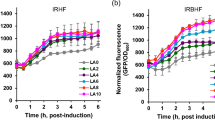Abstract
Although the use of lipases as biocatalysts has frequently been proposed, it is yet scarcely being implemented in industrial processes. This is mainly due to the difficulties associated with the discovery and engineering of new enzymes and the lack of versatile screening methods. In this study, we screened the available strategy from a metagenomic pool for the organic solvent-tolerant lipase with enhanced performance for industrial processes. A novel lipase was identified through functional screening from a metagenomic library of activated sludge in an Escherichia coli system. The gene encoding the lipase from the metagenomic pool, metalip1, was sequenced and cloned by PCR. Metalip1 encoding a polypeptide of 316 amino acids had typical residues essential for lipase such as pentapeptide (GXSXGG) and catalytic triad sequences (Ser160, Asp260, and His291). The deduced amino acid sequence of metalip1 showed high similarity to a putative lipase from Pseudomonas sp. CL-61 (80 %, ABC25547). Metalip1 was expressed in E. coli BL21 (DE3) with a his-tag and purified using a Ni-NTA chelating column and characterized. This enzyme showed high expression level and solubility in the heterologous E. coli host. This enzyme was active over broad organic solvents. Among organic solvents examined, dimethyl formamide was the best organic solvent for metalip1. We showed that function-based strategy is an effective method for fishing out an organic solvent-tolerant lipase from the metagenomic library. Also, it revealed high catalytic turnover rates, which make them a very interesting candidate for industrial application.





Similar content being viewed by others
References
Amann, R. I., Ludwig, W., & Schleifer, K. H. (1995). Microbiological Reviews, 59, 143–169.
Bajpai, P. (1999). Biotechnology Progress, 15, 147–157.
Drepper, T., Eggert, T., Hummel, W., Leggewie, C., Pohl, M., Rosenau, F., Wilhelm, S., & Jaeger, K. E. (2006). Biotechnology Journal, 1, 777–786.
Gitig, D. (2010). Biotechniques, 48, 361–365.
Handelsman, J., Rondon, M. R., Brady, S. F., Clardy, J., & Goodman, R. M. (1998). Chemistry and Biology, 5, R245–249.
Hardeman, F., & Sjoling, S. (2007). FEMS Microbiology Ecology, 59, 524–34.
Jaeger, K. E., & Eggert, T. (2002). Current Opinion in Biotechnology, 13, 390–397.
Jaeger, K. E., Dijkstra, B. W., & Reetz, M. T. (1999). Annual Review of Microbiology, 53, 315–351.
Jeon, J. H., Kim, J. T., Kim, Y. J., Kim, H. K., Lee, H. S., Kang, S. G., Kim, S. J., & Lee, J. H. (2009). Applied Microbiology and Biotechnology, 81, 865–874.
Kim, E. Y., Oh, K. H., Lee, M. H., Kang, C. H., Oh, T. K., & Yoon, J. H. (2009). Applied and Environmental Microbiology, 75, 257–260.
Kim, Y. H., Kwon, E. J., Kim, S. K., Jeong, Y. S., Kim, J., Yun, H. D., & Kim, H. (2010). Biochemical and Biophysical Research Communications, 393, 45–49.
Kim, Y. J., Choi, G. S., Kim, S. B., Yoon, G. S., Kim, Y. S., & Ryu, Y. W. (2006). Protein Expression and Purification, 45, 315–323.
Laemmli, U. K. (1970). Nature, 227, 680–685.
Lee, S. W., Won, K., Lim, H. K., Kim, J. C., Choi, G. J., & Cho, K. Y. (2004). Applied Microbiology and Biotechnology, 65, 720–726.
Morgan, J. L., Darling, A. E., & Eisen, J. A. (2010). PLoS One, 5, e10209.
Park, H. J., Jeon, J. H., Kang, S. G., Lee, J. H., Lee, S. A., & Kim, H. K. (2007). Protein Expression and Purification, 52, 340–347.
Reetz, M. T. (2002). Current Opinion Chemical Biology, 6, 145–150.
Roh, C., Villatte, F., Kim, B. G., & Schmid, R. D. (2005). Electrophoresis, 26, 3055–3061.
Roh, C., & Villatte, F. (2008). Journal of Applied Microbiology, 105, 116–123.
Torsvik, V., & Ovreas, L. (2002). Current Opinion in Microbiology, 5, 240–245.
Turnbaugh, P. J., & Gordon, J. I. (2008). Cell, 134, 708–713.
Zhang, T., Han, W. J., & Liu, Z. P. (2009). Microbial Cell Factory, 8, 67.
Zhao, L. (2010). Nature, 465, 879–880.
Acknowledgments
We are grateful to Prof. Dr. Karl-Heinrich Engesser and Dr. Manfred Roth in the Institute for Sanitary Engineering, Water Quality and Solid Waste Management of the University of Stuttgart for the generous cooperation. This research was supported by the Basic Science Research Program through the National Research Foundation of Korea (NRF), which is funded by the Ministry of Education, Science and Technology (grant no. 2011-0010634).
Author information
Authors and Affiliations
Corresponding author
Rights and permissions
About this article
Cite this article
Roh, C., Schmid, R.D. Isolation of an Organic Solvent-Tolerant Lipolytic Enzyme from Uncultivated Microorganism. Appl Biochem Biotechnol 171, 1750–1758 (2013). https://doi.org/10.1007/s12010-013-0464-z
Received:
Accepted:
Published:
Issue Date:
DOI: https://doi.org/10.1007/s12010-013-0464-z




